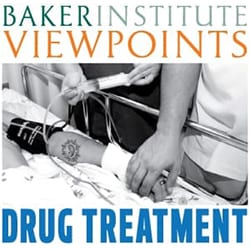Drug policy has experienced an interesting shift recently. Along with legalization of medical and recreational marijuana, many states are also reducing penalties for nonviolent drug offenses and placing greater focus on treatment for drug users. The emphasis on treatment and rehabilitation for drug users is the result of many factors, including recognition that the drug war has not reduced drug use, a desire to reduce the prison population and save money, and a surge in the rate of overdoses from opioid and heroin use. What remains to be seen is whether the current popularity of drug treatment will become a more permanent feature of drug policy. In this Baker Institute Viewpoints series, which runs through Friday, five experts on drug policy examine the question, “Is the current emphasis on treatment in drug policy a short-term trend or is it here to stay?” The third commentary follows. Previous entries covered the stigma surrounding substance use and changing attitudes about the drug war and the user population.
The first marijuana legalization campaign broadcast in Washington state featured a conservatively dressed, coffee-sipping, self-described “Washington mom” saying, “I don’t like it personally, but it’s time for a conversation about legalizing marijuana. It’s a multimillion dollar industry in Washington state, and we get no benefit. What if we regulate it, have background checks for retailers, stiff penalties for selling to minors?” Grinning, she adds, “We could tax it to fund schools and health care. Free up police to go after violent crime instead. And we would control the money, not the gangs.”
This ad, and the success of the legalization campaign it supported, illustrates a powerful trend: the bipartisan “truce” in the war on drugs, fueled by recession-era politics and the understanding that treatment and leniency are less costly than a punitive, unwinnable war.
The centrality of treatment to drug policy was mentioned during the first term of Richard Nixon’s presidency, but immediately eclipsed by federal investment in increasing police power and presence. With the exception of Jimmy Carter, every president has professed strong commitment to the war on drugs. As I argue in “Cheap on Crime,” the Obama administration represents a substantive departure from this trend. While in 2009 the United States was still spending approximately $40 billion per annum fighting the supply side and arresting 1.5 million citizens for drug offenses, Obama’s campaign was atypically silent on the issue, and his presidency took important and significant ameliorative steps — culminating in the Fair Sentencing Act of 2010, the provisions for making the act retroactive, and the introduction of the Smarter Sentencing Act of 2014, which would liberalize drug sentencing. Some of these changes, such as reducing the crack/powder cocaine sentencing disparity, can be attributed to a strong commitment to racial justice, but the ability to make these ideals a reality is largely the product of savings-related, recession-era bipartisan collaborations. In “Cheap on Crime,” I refer to this discourse and the policies it produces as “humonetarianism.”
Indeed, lawmakers, politicians and advocates of all stripes have shifted from punitive stances on drugs, citing the need for financial prudence. The conservative think tank Right on Crime, for example, argues that the traditional libertarian commitment to small government and reasonable expenditures requires investing in evidence-based solutions to the drug problem, rather than in massive, costly incarceration. Similarly, the Smart on Crime coalition has packaged its call for evidence-based solutions to drug trafficking and dependency as a call for austerity and reasonable investments. Many proposals for shifting focus from punitivism to treatment result from bipartisan efforts, such as the Justice Safety Valve Act, a joint effort of Republican Rand Paul and Democrat Patrick Leahy.
The logic behind these federal laws, as well as behind the successful state campaigns to legalize marijuana, is seldom openly about the value of treatment. Instead, the argument at the forefront is related to spending. This rhetoric, as exemplified by New Approach Washington, is about “tak[ing] money away from criminal organizations and generat[ing] tax revenue for our state and local governments.” Supporters of the Colorado campaign reportedly spent financial and rhetorical resources to “focus attention on the fact that we can bring in revenue, redirect law enforcement resources and raise awareness instead of focusing on pot,” because “that’s a message that works.”
The message of savings seems to work better than prior messages about excessive punishment, racial discrimination and misclassification of the problem. But the success of humonetarian discourse raises the question of permanence. When the economy improves, will the government end its truce and resume the punitive war on drugs? My suspicion is that the history of drug criminalization will resemble, if not imitate, the history of alcohol prohibition. Upon recognizing the failure of extensive enforcement (which, in the early 1930s, was also prompted by the need to save money and raise revenue during a serious economic downturn), alcohol policy reverted to be viewed largely through the prism of public health. It is to be hoped that, even though the arguments are largely fiscal, their impact, and the “new normal,” will remain with us after the effects of the recession end.
 Hadar Aviram, Ph.D., M.A., is a professor of law at the University of California Hastings College of Law. Her research focuses on the criminal justice system and examines policing, courtroom practices and broad policy decisions through social science perspectives. Her forthcoming book, “Cheap on Crime: Recession-Era Politics and the Transformation of American Punishment” (University of California Press), analyzes the impact of the financial crisis on the American correctional landscape.
Hadar Aviram, Ph.D., M.A., is a professor of law at the University of California Hastings College of Law. Her research focuses on the criminal justice system and examines policing, courtroom practices and broad policy decisions through social science perspectives. Her forthcoming book, “Cheap on Crime: Recession-Era Politics and the Transformation of American Punishment” (University of California Press), analyzes the impact of the financial crisis on the American correctional landscape.
